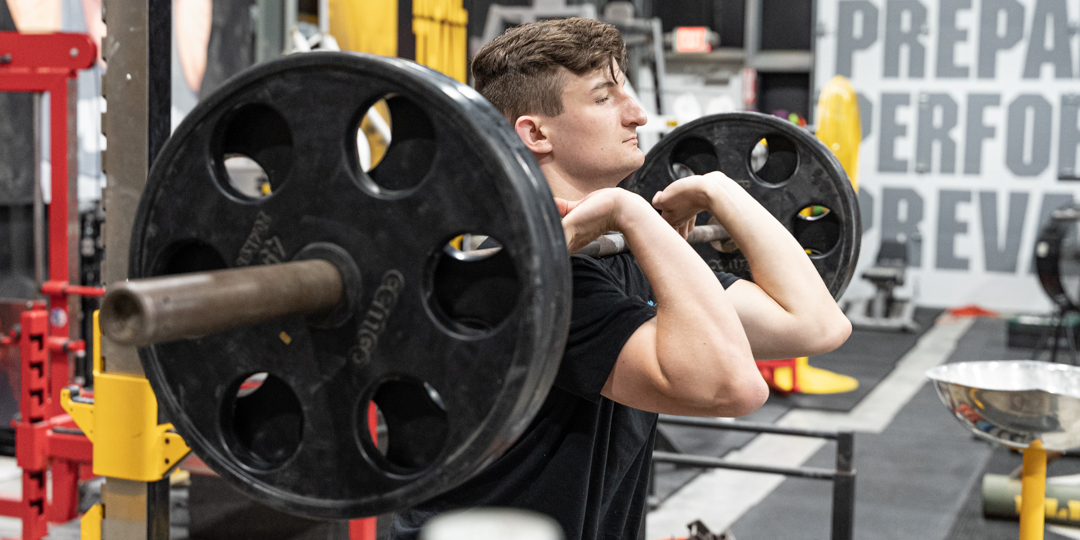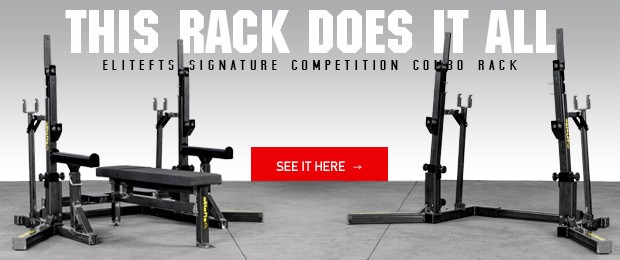
Upon a training journey, you learn how to find solutions for different roadblocks that come about along the way. The deadlift has always been a great lift for me and what I’ve found over time is that the stronger and higher level you get to, the more specific you need to get with your targeting as you run into different challenges along the way. What might work for a 600-pound pull may not work for a 700-pound pull. Sometimes you need to step back and pull out a new map. Here are a few gems that I’ve discovered over the last few years of my travels.
While definitely utilized by Olympic weightlifters, bodybuilders, and various athletes, the front squat does not seem to be as common a staple for powerlifters. Obviously, this is not always the case; however, you definitely do not hear about its application or use as often.
Squat Variation
An obvious reason to use this squat variation as a good assistance movement for the back squat is that it is a more difficult variation. You have less leverage with the bar in front of your body.
Here are some benefits:
- Builds and strengthens quads—which helps with the intial pull off the floor of a deadlift
- Teaches how to brace and strengthen abdominals—if you fail to brace adequately, that bar will let you know real quick.
- Helps remedy falling forward.
These are all great reasons and applications; however, there is another reason to utilize the front squat to help boost your squat and deadlift (especially your deadlift).
Thoracic Extension
Many people fail to realize or think about the fact that front squats work the hell out of your thoracic extension. The entire time you are front squatting, your thoracic extensors are working like crazy to keep your thorax upright. As a matter of fact, if I do miss a heavy front squat, it's almost always because of my thorax losing position, never because of my legs. The first three or four times I attempted to pull 700 pounds in the deadlift, I failed at the knees or just below. Naturally, I hammered specific work to try to improve this supposed weak point with exercises such as band deadlifts, rack pulls, pause deadlifts, Dimel deadlifts, RDL’s, etc. However, after I missed 700 a third time, I decided to analyze the video of the lift closer and from different angles. Upon analysis, I noticed that my upper back was losing position before getting to my knees. I theorized that it was, in fact, my upper back that was to blame for missing these lifts.
Now, rows and face pulls are great, especially for scapular health and balance around the shoulder joint; however, they typically do not directly train thoracic extension. They do not specifically hit the thoracic erectors, which is what seemed to be giving out (bent-over barbell rows will to an extent).
Do you know what does hit all of this?
Front Squats.
Front Squats
I started hitting front squat variations twice a week with both straight weights and bands/chains, and sure enough, as I did them more, my thorax and torso position improved during the front squat more and more. Sure enough, when I deadlifted, I began to notice a difference in the rigidity of my upper back as I pulled. Front squats had been a staple for me in different times throughout my lifting career but hadn’t been as commonplace. In the past, I had always felt that they helped my deadlift; however, I don’t think that I fully realized why.
In addition to front squats working these extensors statically, banded thoracic extensions, thoracic deadlifts, thoracic good mornings, extension shrugs, barbell rows in the deadlift position, and touch-n-go deadlifts also all helped me to improve this weak point by specifically targeting them with different movements and angles.
Regarding the touch-n go-deadlifts, I had done primarily dead-stop deadlifts without a ton of eccentric control for a decent period of time. Band deadlift cycles had worked well for me, and if you’ve ever done deadlifts with a lot of band tension (200-300 pounds of it), you’ll know what I mean when I say there’s not a ton of eccentric activity going on there. Well, I realized that my eccentric abilities sucked and were not up to speed, so I started doing standard touch-n-go deadlifts with a controlled eccentric again. I believe that the stiffness that is required with these helped me solidify and strengthen my upper back stability in addition to the other exercises mentioned above.
Fast forward to now, about a year-and-a-half after beginning to shift focus to this weak point. I finally locked out that 700 with my upper back position remaining intact, tenfold better than it did in the past.
Specifically targeting the thoracic erectors seems like a simple and basic concept to train, yet it is not as commonly thought of. While I won’t sit here and say that this was the only thing to credit for this success, it most definitely played a strong part. While hammering the previously mentioned exercises helped me get over 600 pounds when my sticking point was a little lower, it took the realization that the situation was different this time and that I needed a different plan.
Think you’ve been neglecting your thoracic erectors?
Give some of these ideas a shot. Regardless of what your current situation is, remember that sometimes stepping back and rerouting the map can help to find new successes.
700 Miss
One of my 700 missed attempts, April 2019.
700 at 198
Successful attempt from January 2, 2021. The end-of-the-year meet got canceled, so I said, "screw it" and decided to pull at my gym. I won’t be fully satisfied until I hit this and more at a meet, but I’ll take it for now.
Banded Front Squat
The band tension kicking in at mid-range REALLY challenges that thoracic extension strength.
Thoracic SSB Goodmorning
Stay on the lighter side and go slow.
Thoracic Deadlifts
Shown here with kettlebells but can also be done the same way with a bar in front of you or two bars in landmines at your sides.
Banded Thoracic Extensions
These have the added benefit of strengthening your lower neck extensors and deep neck flexors.

Nick Rosencutter is the founder and owner of Rosencutter Ultra Fitness & Performance in Greenfield, Wisconsin. He is a certified strength and conditioning specialist and a certified personal trainer through the National Strength and Conditioning Association, a licensed massage therapist, Full Body Level 2 Active Release Techniques provider with Elite Provider designation, and is currently studying courses from the Postural Restoration Institute.










Thanks Jarad